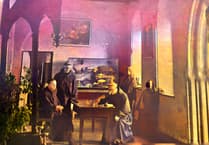ON the eve of the 20th century something historic was happening in Brynmawr. On December 27, 1899, the inhabitants of the highest town in Wales settled down to watch the first moving film to be shown at Brynmawr Cinema. It was a Boer War pictorial!
Although the film had no superstars, no plot loaded with twists and turns, no standout soundtrack or groundbreaking CGI, every frame was filled with the elusive magic and wonder of pictures that moved.
Over 120 years later people still head in droves to the oldest cinema in Wales, or as it’s affectionally known, the ‘grand old lady of Brynmawr’ to buy their popcorn, take their seat, kick back, and let the big screen cast its strange spell of enchantment over them.
In a world that is often far too real, chaotic, and dull, a trip to the pictures is just the tonic. At the movies, a soul can lose themselves for a couple of hours or so in a world of imagination and glorious technicolor.
The childlike awe most of us experience during our first trip to the pictures is something that stays buried deep within us and is reawakened in part with each subsequent visit.
The darkened auditorium, the hushed atmosphere, the velvet opulence, the air of heavy expectancy, and the huge curtains that slowly part to reveal a blank canvas that will soon be painted with masterworks of endless possibility.
All of these things conspire to create an ambience that borders on the mystical. If going to the movies is akin to a religious rite then you need a ‘church’ fit for purpose.
Streaming platforms are all well and good, but watching a film in isolation on a small screen not fit for purpose is hardly the communal experience that the craft of skilled movie-making warrants.
For the magic of moving pictures to truly work, the screen must be big enough to block out reality, the sound loud enough to leave little thought for what is happening elsewhere, and the room vast enough to turn the process of movie-going into a tribal affair.
In short, when you step off the streets into a foyer of a cinema you should feel you’re crossing the threshold of one reality to another. The world ends at the cinema’s door and something new, strange, and different awaits within.
For this to happen, you need a building that is one step removed from the modern world, a building that is soaked in history, and a building whose very fabric has absorbed the dreams, joys, sorrows, love, loss, and wonder of generations of cinema-goers. You need Wales’s oldest cinema! And we should all be thankful the grand old lady of Brynmawr isn’t just still standing but thriving as she celebrates her 130th anniversary.
When it first opened its doors in 1894 as a new market hall that would serve as a wholesale market and a place for public meetings and entertainment, no one could have imagined what the building would one day become.
However, fate has a way of stepping in and bending things to its will. A scattering of traveling theatre companies and those that specialized in the new and strange practice of Myrioramas and Panoramas began visiting and putting the building on the map.
The first showing was on June 25, 1894, when Harry Poole’s “unprecedented variety amalgamation of the advance and engagement of the Spanish Armada” was shown. It was rudimentary stuff compared with today’s technical wizardry, but a foundation had been laid, the grand old lady of Brynmawr had awoken to a dream that would never end.
Once the ball was rolling, momentum began to build. Just before World War One, one Mr. Dooner obtained a lease from the town council to show silent films accompanied by an orchestra and the game was afoot.
A couple of global pandemics, two World Wars, seven monarchs, and 33 Prime ministers later, and the ‘old lady’ may be a little frayed around the edges, but her glamour and air of mystery hasn’t faded any. She’s still doing what she was born to do - applying the slap, putting on a show, and entertaining the masses.
Yet the journey from there to now hasn’t always been easy for the little picture house with a big history.
As Market Hall Cinema and Arts Trust chair Beth Watkins told the Chronicle, “The Trust took over the running of the cinema from the council in 2013 and saved it from being closed. Then, in 2014 we were named UK Cinema of the Year. However, two years later we were forced to close for six months when asbestos was found in the building.”
As the days ticked by and the silver screen remained devoid of life, fears began to grow that the grand old lady’s time was finally up. Yet they proved unfounded when on the back of a huge surge of community goodwill and effort, new patron Michael Sheen reopened the cinema in the Summer of 2017. Aptly, the film shown to mark the occasion was the 1946 classic “A Matter of Life and Death.”
Beth recalls, “I remember Martin giving a speech to the audience ahead of the film. He said something along the lines of how many memories this old building had created and how many people the back row of the cinema had helped create. I thought that cheekily but poignantly captured the cinema’s role as a focal point in the community.”
Beth added, “During the time we were shut, we really felt the passion people felt for this place. We were receiving donations and messages from all over the world. Children were even donating their pocket money, the wave of goodwill was absolutely astronomical. As a registered charity we’ve always run the cinema as a labour of love, and because of the support we received during the six months or so we were shut, we knew we had to reopen. So many people were counting on us.”
Upon their grand reopening, both breeze and tide were favourable for the iconic building. In early 2020 the Market Hall Cinema and Arts Group was set to take over the freehold from Blaenau Gwent Council and then Covid struck and turned everything on its head.
Beth explained, “What is it they say about best-laid plans? Needless to say, we had to put everything on hold and play the waiting game. Lockdown was an anxious time for everyone because no one knew when it would be over, and it took a long time for the hospitality and leisure industry to bounce back.
“All in all, the various lockdowns and restrictions entailed we were out of action for about 17 months. Fortunately, the government grants entailed we could keep our staff on furlough and we used the time to clean, renovate, and decorate for the day when we could finally bounce back.”
In a space of less than five years, the cinema staged its second grand reopening. This time of course, there was a one-way system, sanitizing stations, face masks, and Covid passes in place of Martin Sheen. Nevertheless, the affection and love everyone still had for the grand old lady remained evident for all to see.
“The support has been fantastic,” explained Beth, “And although numbers have dipped slightly since Covid, the same is true for the UK cinema industry as a whole, but thanks to our loyal customers, we continue to fight our corner and hold our own.”
In May 2022 the Market Hall Cinema and Arts Group finally took the grand old lady of Brynmawr into their care. With plans underway to convert the old hall next door into a second screen and concert stage the future is looking positively cinematic!
However, corporate cinema chains that rhyme with the word blue are a dirty word as far as everyone who works in Brynmawr Pictures is concerned. As Beth stresses, “We’re more known as the pictures than the cinema and it’s a point of pride with us that we keep both our ticket and snack prices low. Compared with the big players, what we offer is a bargain, but we don’t see it that way. We believe that no one should be priced out of going to the pictures. Since our refurbishment and new seats, people have got all the legroom they could possibly want, and we have the added advantage of having a 195-seat auditorium that has 130 years of history. You can feel all that romance and mystery as soon as you walk in here and that’s not something you can easily replicate.”
If the grand old lady of Brynmawr has one thing, it’s character. Being gifted the opportunity to walk around an auditorium devoid of people, pictures, and sound, is a strange experience but one that makes you realize what special places independent cinemas are. They have a proud history of offering generation after generation a much-needed escape from the grind of everyday life.
“Of course, if you came here last week it would have been jam-packed full of screaming kids,” explains trustee Andrea Durban. “Things always go a little crazy during half-term holidays”
And the passion for going to the pictures that develops in childhood often continues to a ripe old age.
Beth explained, “A while back we had a 92-year-old gentleman travel from Newport on the bus. He had heard the cinema he had often visited as a child had reopened and he said he just had to see it one last time. We showed him around and there were tears in his eyes. It’s so touching to think an old building can mean so much to so many people because of what they’ve experienced here.”
A cursory glance around the cinema and you’ll notice name plaques on the back of many chairs. It’s not done out of some sense of private ownership but a testament to the cinema’s place at the heart of a close-knit community.
“For a donation, you can sponsor a chair and have someone’s name placed upon it,” explained Beth. “It’s proved very popular. My father-in-law has one because when he died my mother-in-law said I think he owes the cinema a seat for all the times he used to run all the way from Clydach as a boy and sneak in without paying,” she laughed.
Each name plaque is a telling reminder of how a building whose business is the telling of stories has played an integral part in the story of so many people who have sat and been moved in these seats.
Forever playing host to unique screenings to help set them apart from the corporate chains. Brynmawr Cinema has in the past screened classics such as ‘Brief Encounter’ and served up tea in china cups and Welsh cakes. Beth explained, “That was a funny one because it was the first time a lot of kids in the audience had seen a black and white film, and they were all complaining that the screen was not working properly.”
Beth added, “Another time we showed ‘It’s A Wonderful Life’. So many people began crying because they didn’t appreciate the effect watching a film like that surrounded by people in a historic cinema would have when compared to watching it on TV. And that’s pretty much why we keep on keeping on and will do so until the end credits finally roll.”




Comments
This article has no comments yet. Be the first to leave a comment.